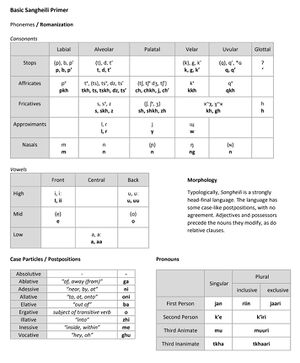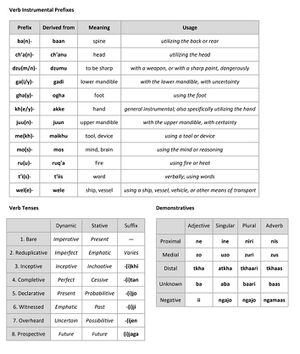Halo (série télévisée)/Sangheili


Le sangheili est la langue parlée par l'espèce éponyme dans la Silver Timeline, l'univers alternatif de la série Halo. Cette langue a été conçue par David J. Peterson[1] et Carl Buck,[2] leur travail ayant commencé en avril 2019.[3]
Les dialogues en sangheili dans la série sont officiellement transcrits et traduits en anglais sur Archive Of Our Own.
Phonologie et translitération
Les sons sont indiqués entre crochets selon la nomenclature IPA et suivis entre parenthèses de leur translitération dans l'alphabet latin. La translitération suit en règle générales des nomenclatures utilisées en anglais.
Consonnes
| Labiales | Alvéolaires | Palatales | Vélaires | Uvulaires | Glottales | |
|---|---|---|---|---|---|---|
| Occlusives | [p] (p), [b] (b), [p'] (p') | [t] (t), [d] (d), [t'] (d') | [k] (k), [g] (g), [k'] (k') | [q] (q), [q'] (q'), *ɢ | ʔ (') | |
| Affriquées | [px] (pkh) | [tx] (tkh), [t͡s] (ts), [tsx] (tskh), [d͡z] (dz), [ts'], (ts') | [tʃ] (ch), [tʃx] (chkh), [dʒ] (j), [tʃ'] (ch') | [kx] (kkh) | [qx] (qkh) | |
| Fricatives | [s] (s), [sx] (skh), [z] (z) | [ʃ] (sh), [ʃx] (shkh), [ʒ] (zh) | [x~χ] (kh), [ɣ~ʁ] (gh) | [h] (h) | ||
| Spirantes | [l] (l), [ɾ] (r) | [j] (y) | [ɰ] (w) | |||
| Nasales | [m] (m) | [n] (n) | [ɲ] (n) | [ɳ] (ng) | [ɴ] (n) | |
Certains sons présents dans des noms propres existants mais absents de la phonologie sangheilie sont des approximations dues à une latinisation des noms par les humains :[4][5][6]
- [f] est prononcé [p]
- [θ] est prononcé [t]
- [v] est prononcé [b]
Voyelles
| Antérieures | Centrales | Postérieures | |
|---|---|---|---|
| Fermées | [i] (i), [iː] (ii) | [u] (u), [uː] (uu) | |
| Moyennes | [e] (e) | [o] (o) | |
| Ouvertes | [a] (a), [aː] (aa) |
Grammaire et morphologie
Le Sangheili est une langue centripète, qui place dans une phrase les éléments modificateurs avant les éléments modifiés, et privilégie les postpositions.
Pronoms personnels
| Singulier | Pluriel | ||
|---|---|---|---|
| Inclusif | Exclusif | ||
| Première personne | jan | riin | jaari |
| Deuxième personne | k'e | k'iri | |
| Troisième personne animé | mu | muuri | |
| Troisième personne inanimé | tkha | tkhaari | |
Cas grammaticaux
Ces particules se placent après leur objet.
| Ablatif | ga |
|---|---|
| Adessif | ni |
| Allatif | oni |
| Élatif | ba |
| Ergatif | o |
| Illatif | zhi |
| Inessif | me |
| Vocatif | ghu |
Aspects et temps
| Dynamique | Statique | Suffixe | |
|---|---|---|---|
| Non conjugué | Impératif | Présent | |
| Redoublement | Imparfait | Emphase | Irrégulier |
| Inceptif | Inceptif | Inchoatif | -(i)khi |
| Complétif | Accompli | Terminatif | -(i)tan |
| Déclaratif | Présent | Probable | -(i)jo |
| Observé | Emphase | Passé | -(i)ji |
| Rapporté | Incertain | Possible | -(i)jen |
| Prospectif | Futur | Futur | -(i)jaga |
| Question oui/non | -jahe[7] |
Particules démonstratives
| Adjectif | Pronom singulier | Pronom pluriel | Adverbe | |
|---|---|---|---|---|
| Proximal | ne | ine | niri | nis |
| Médial | zo | uzo | zuri | zus |
| Distal | tkha | athka | tkhaari | tkhaas |
| Inconnu | ba | aba | baari | baas |
| Négatif | ii | ngajo | ngamaas | |
Vocabulaire
- akke : main
- baan : colonne vertébrale
- ch'anu : tête
- domo : humain
- dzumu : coupant, effilé
- gadi : mandibule inférieure
- ghashanko : Démon[8]
- juun : mandibule supérieure
- maikhu : outil, appareil
- mos' : cerveau, esprit
- ogha : pied
- oq’ogakha : artéfact, relique forerunner[9]
- ruq'a : feu
- t'iis : mot
- warut'o : « Allez ! » (évolution du « Wort, wort, wort! » entendu dans Halo : Combat Evolved)[10]
- wele : vaisseau
- Q'iitu : Pitié[10]
- Ghashank'o : Démon[10]
- kheluuga : artefact[11]
- Maduriga: Madrigal[11]
- K’uucho: guerrier[11]
The Ballad of Kel 'Darsam
Il s'agit de huit lignes extraites d'un poème plus long.
| Anglais | Sangheili |
|---|---|
| Born of woman, fathered by Deity, Kel ‘Darsam was a pillar of piety, | Dzana bojo ba, aamu nejo ba, K’elo Daasamu moq’aaji, ch’anaani, |
| Brave and noble, strong and wise, he sought only justice and no other prize, | Dzima ze oq’o, haala ze khoya, gaibaat’u ba q’a bak’ontu maaroji, |
| He battled with monsters, slew terrible beasts, to make his lands safe and to guarantee peace, | Mu o ghashank’o dzuk’uuchi, matkhaji; tkhaati’ni baat’u, dzukhunt’u waqkho’ni, |
| But jealous were others, who envied his grace, a rival Kaidon sought his rival’s disgrace, | Q’a k’unjo’ mu’m ch’apkhaat’u ghamaaziji, K’aidon o mu juutkhoma maaroji, |
| But a cowardly fighter, disgraced and defeated, took aim at the two as they finally retreated, | Q’a juutkhaat’u ba nuju k’uucho o muuri ni welekkhosa ni dzushkhaatan, |
| Kel ‘Darsam fell, spear in his back, down to the rocks where the waves did crack, | Mu ni baan me luk’a o K’elo Daasamu mogha ni gakha oni ts’aatan, |
| But as Kel was falling, the sun was arising, the first rays of Urs halted ‘Darsam’s demising, | K’elo ni ts’aha ni has o ruuekhi tkhazhi Daasamu ba q’ii pkhadatan, |
| The light found him godly with noble intention, and embraced him as kin and confirmed his ascension. | K’iis o aamu ni mu maaroji, tkhazhi tkha o tkhet’a oni mu juuch’iitan.[12] |
References
- ↑ Twitter - David J. Peterson, « Ecstatic to be able to finally share the news that @tlacamazatl and I have been working for the last three years on the #Sangheili language for @HaloTheSeries, premiering tonight. We look forward to sharing more about the language with you as the season progresses! »
- ↑ Twitter - C. Buck, « If you have #ParamountPlus, are a fan of #HaloSeries, and enjoy a good #conlang. You might be interested to know that I helped @Dedalvs develop the language for the Covenant. I hope you enjoy it. »
- ↑ Twitter - David J. Peterson, « But yeah, this is what @tlacamazatl and I have been working on and with since April 2019. :) Hope you enjoy it. »
- ↑ Twitter - David J. Peterson
- ↑ Twitter - David J. Peterson
- ↑ AO3 - Conlang Dialogue: Halo, Episode 108
- ↑ Twitter - David J. Peterson
- ↑ Twitter - C. Buck
- ↑ Twitter - C. Buck
- ↑ 10,0 10,1 et 10,2 AO3 - Conlang Dialogue: Halo, Episode 101
- ↑ 11,0 11,1 et 11,2 AO31 - Conlang Dialogue: Halo, Episode 105
- ↑ AO3 - Conlang Dialogue: The Ballad of Kel Darsam